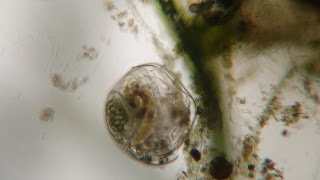I viewed my aquarium for the final time on November 9, 2010. It is sad to see my project end as it has really come to life. I was able to see a nematode as well as other organisms pictured below. I believe the food that was added 2 weeks ago spawned a great boost of organisms. Well, on to my lab report to finish my project and Botany 111.
Cladocera Daphnia is a shrimp like, small crustacean with a shell-like enclosure (1).
Not yet identified
_________________________________________________
(1) Thorp, James and Alan Covich. Ecology and Classification of North American Freshwater invertabrates (1991). Academisc Press, Inc. Page 752, Figure 20.27.










